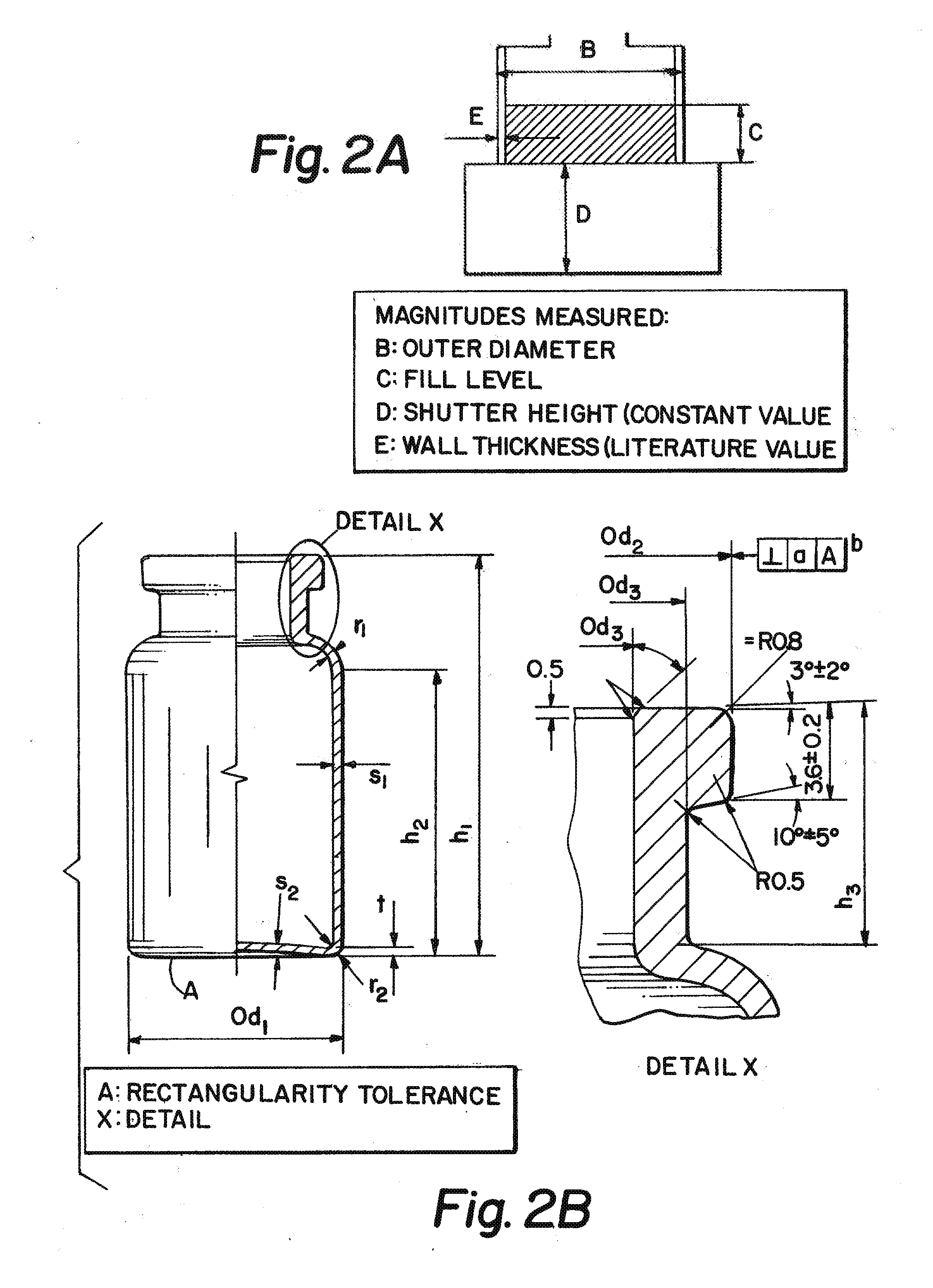Optical measurement of fill level
- Summary
- Abstract
- Description
- Claims
- Application Information
AI Technical Summary
Benefits of technology
Problems solved by technology
Method used
Image
Examples
example 1
Measuring Principle and Preliminary Tests
[0164]FIG. 1 shows the operating principle of the optical measurement of fill level using a camera system. The vial is moved past a camera by a transporting system (star wheel, conveyor belt . . . ). The object is generally illuminated by background lighting for optimum image recording. The image capture is controlled by an external trigger which detects each individual vial.
[0165]The camera and trigger are linked together by a controller which contains the software. The image and the measured results are delivered directly using a monitor which is also linked to the controller.
[0166]The controller is actuated by a control console or an external PC / laptop.
[0167]In order to test the basic feasibility of the optical monitoring of fill levels using a camera system, first of all the following preliminary tests were carried out:
[0168]Measurement of[0169]20R vials at rest,[0170]20R vials on a conveyor belt and[0171]2R vials on a conveyor belt.
[0172...
example 2
Measurement of Fill Level in a Filling Machine
[0186]After the preliminary tests had demonstrated the basic feasibility of optically measuring fill level with a camera system, further tests were carried out with 20R vials and with 2R vials on two different filling machines.
20R Vials on INOVA No. 5:
[0187]The measuring arrangement was implemented in the filling machine as described in the preliminary tests / Example 1.
[0188]100 vials were filled with a desired fill volume of 20.0 ml of purified water at a rate of 3.5 SKT (approx. 1200 vials / h) and then stoppered.
[0189]On leaving the star wheel, the fill level of each vial was measured using the camera system.
[0190]Each individual vial was weighed before and after filling (without a stopper) in order to determine the precise fill volume.
[0191]The average of the 100 measurements is 19.81 ml. The standard deviation from the mean is 0.49 ml.
[0192]78% of the vials measured fall within the tolerance of ±0.5 ml deviation from the desired value ...
example 3
Measurement of Fill Level in Filling Machines with Optimised Mechanical Features and Optimised Settings
[0253]On the basis of the tests described under “EXAMPLE 2” mechanical adaptations were made to the filling machines and technical improvements were also made to the camera and programmes.
[0254]For sizes 2R, 10R and 20R the size components for separating the vials and the holders for the camera and background lighting were improved.
[0255]The height of the camera, the distance of the measured object and the appropriate lens for each of the three sizes of vial were selected to be the best possible and adjusted accordingly.
[0256]The camera programmes of the three sizes of vial were optimised to increase the precision and constructed analogously to one another (see FIG. 7).
[0257]The most important adaptations are:[0258]Measurement of the outer diameter only to scale pixels to millimetres. The published value is used to calculate the fill volume.[0259]No direct measurement of the base t...
PUM
| Property | Measurement | Unit |
|---|---|---|
| fill volume | aaaaa | aaaaa |
| fill volume | aaaaa | aaaaa |
| fill volume | aaaaa | aaaaa |
Abstract
Description
Claims
Application Information
 Login to View More
Login to View More - R&D
- Intellectual Property
- Life Sciences
- Materials
- Tech Scout
- Unparalleled Data Quality
- Higher Quality Content
- 60% Fewer Hallucinations
Browse by: Latest US Patents, China's latest patents, Technical Efficacy Thesaurus, Application Domain, Technology Topic, Popular Technical Reports.
© 2025 PatSnap. All rights reserved.Legal|Privacy policy|Modern Slavery Act Transparency Statement|Sitemap|About US| Contact US: help@patsnap.com



